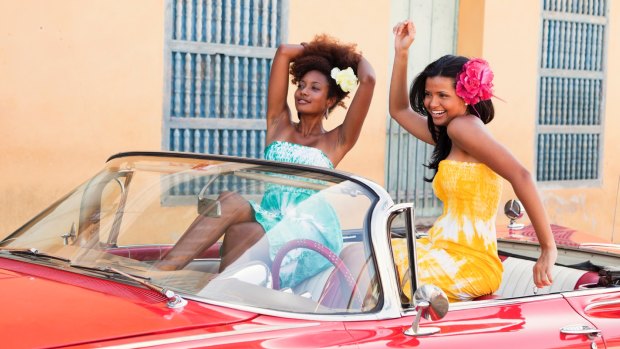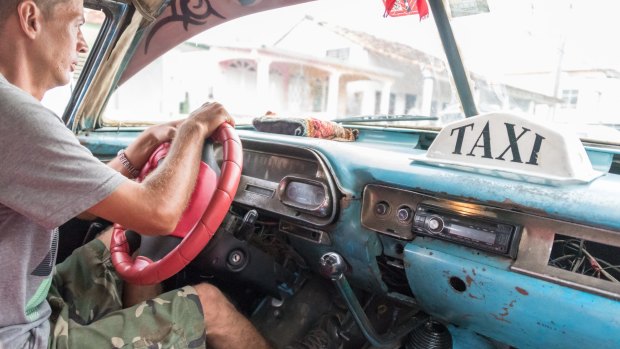By Sue Williams

Cuban transport is highly entertaining.Credit: iStock
"You wanna go to Havana?" asks the owner of our b&b on the outskirts of Cienfuegos, 240 kilometres away on Cuba's southern coast. "No problem. Easy."
He declines to elaborate further, concentrating all his energies instead on persuading us to have a few dozen more mojitos before bed.
The next morning, he drives us into town and drops us on a busy street corner. "Farewell my friends!" he yells over the pounding of his ancient motor. "Buen viaje!"

Cuba is famous for its vintage American cars still plying the roads.Credit: Roberto Machado Noa
We stand for a moment, wondering what to do next. Why has he abandoned us when he'd seemed so helpful the night before? How could he do this to us when we've lined his family's pockets with mojito gold?
A man appears suddenly by our side, out of breath from running across the busy road. "Where are you going?" he asks. "Havana," we chime. "OK," he says. "We'll take you for $20 each." A car not so much screeches, as clanks, to a halt beside us. "Get in."
It takes us a good five creaking hours to reach the capital but it's worth it. In that time, we've made two new friends – two mates having to go to Havana to renew their driving licences and our contribution covers the cost of the journey – heard about daily life in Cuba, and drunk excellent coffee together in one of the best roadside cafes you'd normally never hear about.
The driver took my bag and pushed it into the boot through a hole in the back seat.
For that is one of the constant joys of travelling in Cuba. Every Cuban is eager to make an honest buck, whether by providing accommodation, becoming an instant tour guide, or by helping a tourist get from A to B.
As a result, it makes transport in Cuba a hugely entertaining, if rarely efficient, affair.
We all know about the fabulous vintage cars that have survived boycotts, blockades and breakdowns. Indeed, a ride in one is a must on any visit to Cuba. What you tend not to hear about, though, are the fumes that waft from the vintage 1950s leaving you choking not with nostalgia but gasping for breath.
Nonetheless, hiring a 1952 Chevy, a 1954 Buick, or a '55 Lincoln – with or without driver – for a city tour or a longer trip can't be missed.
But there are other ways of getting around besides those carefully preserved relics.
Most Cubans don't own cars but those who do will usually have battered Ladas from the '70s and '80s. They've been bashed and bumped, repaired and rejuvenated all their lives, and often bear scars that would have seen them scrapped long ago in the West.
When I went to put my bag in the boot of one, the driver took it from my hands and pushed it into the boot through a hole in the back seat. "Not work," he nodded towards the boot lid. "Welcome to Cuba!"
There's a culture of sharing in the country, typified by seeing how many people can be packed into a taxi or a private car to split the cost. Hitch-hiking is widely accepted, with passengers waving pesos rather than thumbs to show they can pay their way.
Sadly, there aren't many working trains left in Cuba, the cheapest local bus network is slow and the slightly more expensive express bus network that tourists tend to use only marginally faster.
More fun are the Coco-taxis, bright yellow tuktuk-type bubbles set on a motorbike engine, with passengers on a bench seat behind. They zip around town, alarmingly fast and fragile-feeling when you're looking up at the massive wheels of passing trucks. It doesn't help either that the driver wears a crash helmet – and you don't.
Somehow, the bicycle taxis, with a little carriage pulled by an old-fashioned pushbike feel safer. They don't mind, either, if you want a turn at pedalling them along
Far more leisurely are the carts jolted along by horses, donkeys or mules trotting through most of Cuba's country towns. Any thought that they're only for the tourist trade evaporates when you see them hauling timber and bricks in the slow lane of a six-lane highway.
Cuba may be on the road to recovery – but it's still a horse-drawn, hitch-hiking, pedal powered, straight-eight, stop-start journey for most of the locals.
TRIP NOTES
MORE INFORMATION
GETTING THERE
Qantas flies direct to Dallas, then American Airlines flies to Mexico City, and finally either AeroMexico or Air Cubana continues to Havana.
STAYING THERE
The casas particulares (private b&bs operated by Cuban families) have their own network; see bbinnCuba.com
TRAVELLING THERE
Hail any vintage car, bicycle taxi, Coco-taxi, regular taxi or animal-drawn cart to organise a ride. Stand in a street near a bus station with a suitcase for a ride to be organised for you. Bus tickets are best booked in advance to avoid queues.
Sue Williams travelled at her own expense.
Sign up for the Traveller Deals newsletter
Get exclusive travel deals delivered straight to your inbox. Sign up now.